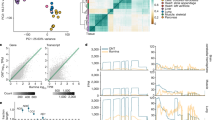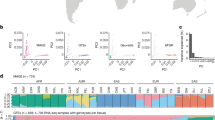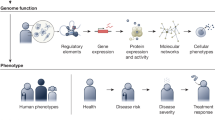Abstract
Genome sequencing projects are discovering millions of genetic variants in humans, and interpretation of their functional effects is essential for understanding the genetic basis of variation in human traits. Here we report sequencing and deep analysis of messenger RNA and microRNA from lymphoblastoid cell lines of 462 individuals from the 1000 Genomes Project—the first uniformly processed high-throughput RNA-sequencing data from multiple human populations with high-quality genome sequences. We discover extremely widespread genetic variation affecting the regulation of most genes, with transcript structure and expression level variation being equally common but genetically largely independent. Our characterization of causal regulatory variation sheds light on the cellular mechanisms of regulatory and loss-of-function variation, and allows us to infer putative causal variants for dozens of disease-associated loci. Altogether, this study provides a deep understanding of the cellular mechanisms of transcriptome variation and of the landscape of functional variants in the human genome.
This is a preview of subscription content, access via your institution
Access options
Subscribe to this journal
Receive 51 print issues and online access
$199.00 per year
only $3.90 per issue
Buy this article
- Purchase on SpringerLink
- Instant access to full article PDF
Prices may be subject to local taxes which are calculated during checkout




Similar content being viewed by others
Accession codes
Accessions
ArrayExpress
Data deposits
The Geuvadis RNA-sequencing data, genotype data, variant annotations, splice scores, quantifications, and QTL results are freely and openly available with no restrictions. The main portal for accessing the data is EBI ArrayExpress, under accessions E-GEUV-1, E-GEUV-2 and E-GEUV-3 (see the data access schema in Supplementary Fig. 39). For visualization of the results we created the Geuvadis Data Browser (http://www.ebi.ac.uk/Tools/geuvadis-das) where quantifications and QTLs can be viewed, searched and downloaded (Supplementary Fig. 40). The project webpage (http://www.geuvadis.org) provides full documentation and links to all files, and the analysis group wiki is open to the public (http://geuvadiswiki.crg.es).
References
Abecasis, G. R. et al. An integrated map of genetic variation from 1,092 human genomes. Nature 491, 56–65 (2012)
The Wellcome Trust Case Control Consortium. Genome-wide association study of 14,000 cases of seven common diseases and 3,000 shared controls. Nature 447, 661–678 (2007)
Dunham, I. et al. An integrated encyclopedia of DNA elements in the human genome. Nature 489, 57–74 (2012)
Emilsson, V. et al. Genetics of gene expression and its effect on disease. Nature 452, 423–428 (2008)
Stranger, B. E. et al. Population genomics of human gene expression. Nature Genet. 39, 1217–1224 (2007)
Grundberg, E. et al. Mapping cis- and trans-regulatory effects across multiple tissues in twins. Nature Genet. 44, 1084–1089 (2012)
Montgomery, S. B. et al. Transcriptome genetics using second generation sequencing in a Caucasian population. Nature 464, 773–777 (2010)
Pickrell, J. K. et al. Understanding mechanisms underlying human gene expression variation with RNA sequencing. Nature 464, 768–772 (2010)
Nica, A. C. et al. Candidate causal regulatory effects by integration of expression QTLs with complex trait genetic associations. PLoS Genet. 6, e1000895 (2010)
Nicolae, D. L. et al. Trait-associated SNPs are more likely to be eQTLs: annotation to enhance discovery from GWAS. PLoS Genet. 6, e1000888 (2010)
Hoen, P. A. C. et al. Reproducibility of high-throughput mRNA and small RNA sequencing across laboratories. Nature Biotech http://dx.doi.org/10.1038/nbt.2702 (in the press)
Gonzalez-Porta, M., Calvo, M., Sammeth, M. & Guigo, R. Estimation of alternative splicing variability in human populations. Genome Res. 22, 528–538 (2012)
Merkin, J., Russell, C., Chen, P. & Burge, C. B. Evolutionary dynamics of gene and isoform regulation in mammalian tissues. Science 338, 1593–1599 (2013)
Barbosa-Morais, N. L. et al. The evolutionary landscape of alternative splicing in vertebrate species. Science 338, 1587–1593 (2012)
Parts, L. et al. Extent, causes, and consequences of small RNA expression variation in human adipose tissue. PLoS Genet 8, e1002704 (2012)
Xiao, C. & Rajewsky, K. MicroRNA control in the immune system: basic principles. Cell 136, 26–36 (2009)
Ebert, M. S. & Sharp, P. A. Roles for microRNAs in conferring robustness to biological processes. Cell 149, 515–524 (2012)
Pickrell, J. K., Pai, A. A., Gilad, Y. & Pritchard, J. K. Noisy splicing drives mRNA isoform diversity in human cells. PLoS Genet. 6, e1001236 (2010)
Lee, Y. et al. Variants affecting exon skipping contribute to complex traits. PLoS Genet. 8, e1002998 (2012)
Djebali, S. et al. Landscape of transcription in human cells. Nature 489, 101–108 (2012)
Cordaux, R. & Batzer, M. A. The impact of retrotransposons on human genome evolution. Nature Rev. Genet. 10, 691–703 (2009)
Veyrieras, J. B. et al. High-resolution mapping of expression-QTLs yields insight into human gene regulation. PLoS Genet. 4, e1000214 (2008)
Gaffney, D. J. et al. Dissecting the regulatory architecture of gene expression QTLs. Genome Biol. 13, R7 (2012)
McDaniell, R. et al. Heritable individual-specific and allele-specific chromatin signatures in humans. Science 328, 235–239 (2010)
Degner, J. F. et al. DNase I sensitivity QTLs are a major determinant of human expression variation. Nature 482, 390–394 (2012)
Hindorff, L. A., Junkins, H. A., Hall, P. N., Mehta, J. P. & Manolio, T. A. A Catalog of Published Genome-Wide Association Studies; available at http://www.genome.gov/gwastudies (accessed 11 September 2012)
O’Seaghdha, C. M. et al. Common variants in the calcium-sensing receptor gene are associated with total serum calcium levels. Hum. Mol. Genet. 19, 4296–4303 (2010)
MacArthur, D. G. et al. A systematic survey of loss-of-function variants in human protein-coding genes. Science 335, 823–828 (2012)
Nagy, E. & Maquat, L. E. A rule for termination-codon position within intron-containing genes: when nonsense affects RNA abundance. Trends Biochem Sci. 23, 198–199 (1998)
Montgomery, S. B., Lappalainen, T., Gutierrez-Arcelus, M. & Dermitzakis, E. T. Rare and common regulatory variation in population-scale sequenced human genomes. PLoS Genet. 7, e1002144 (2011)
Marco-Sola, S., Sammeth, M., Guigo, R. & Ribeca, P. The GEM mapper: fast, accurate and versatile alignment by filtration. Nature Methods 9, 1185–1188 (2012)
Pantano, L., Estivill, X. & Marti, E. SeqBuster, a bioinformatic tool for the processing and analysis of small RNAs datasets, reveals ubiquitous miRNA modifications in human embryonic cells. Nucleic Acids Res. 38, e34 (2010)
Harrow, J. et al. GENCODE: the reference human genome annotation for The ENCODE Project. Genome Res. 22, 1760–1774 (2012)
Kozomara, A. & Griffiths-Jones, S. miRBase: integrating microRNA annotation and deep-sequencing data. Nucleic Acids Res. 39, D152–D157 (2011)
Stegle, O., Parts, L., Durbin, R. & Winn, J. A Bayesian framework to account for complex non-genetic factors in gene expression levels greatly increases power in eQTL studies. PLOS Comput. Biol. 6 e1000770 10.1371/journal.pcbi.1000770 (2010)
Acknowledgements
We would like to thank E. Falconnet, L. Romano, A. Planchon, D. Bielsen, A. Yurovsky, A. Buil, J. Bryois, A. Nica, I. Topolsky, N. Fusi, S. Waszak, C. Bustamante, J. Rung, N. Kolesnikov, A. Roa, E. Bragin, S. Brent, J. Gonzalez, M. Morell, A. Puig, E. Palumbo, M. Ventayol Garcia, J. F. J. Laros, J. Blanc, R. Birkelund, G. Plaja, M. Ingham, J. Camps, M. Bayes, L. Agueda, A. Gouin, M.-L. Yaspo, E. Graf, A. Walther, C. Fischer, S. Loesecke, B. Schmick, D. Balzereit, S. Dökel, M. Linser, A. Kovacsovics, M. Friskovec, C. von der Lancken, M. Schlapkohl, A. Hellmann, M. Schilhabel, the SNP&SEQ Technology Platform in Uppsala, S. Sauer, the Vital-IT high-performance computing centre of the SIB Swiss Institute of Bioinformatics, B. Goldstein and others at the Coriell Institute, and J. Cooper, E. Burnett, K. Ball and others at the European Collection of Cell Cultures (ECACC) and the 1000 Genomes Consortium. This project was funded by the European Commission 7th Framework Program (FP7) (261123; GEUVADIS); the Swiss National Science Foundation (130326, 130342), the Louis Jeantet Foundation, and ERC (260927) (E.T.D.); NIH-NIMH (MH090941) (E.T.D., M.I.M., R.G.); Spanish Plan Nacional SAF2008-00357 (NOVADIS), the Generalitat de Catalunya AGAUR 2009 SGR-1502, and the Instituto de Salud Carlos III (FIS/FEDER PI11/00733) (X.E.); Spanish Plan Nacional (BIO2011-26205) and ERC (294653) (R.G.); ESGI, READNA (FP7 Health-F4-2008-201418), Spanish Ministry of Economy and Competitiveness (MINECO) and the Generalitat de Catalunya (I.G.G.); DFG Cluster of Excellence Inflammation at Interfaces, the INTERREG4A project HIT-ID, and the BMBF IHEC project DEEP SP 2.3 (P.Ro.); German Centre for Cardiovascular Research (DZHK) and the German Ministry of Education and Research (01GR0802, 01GM0867, 01GR0804, 16EX1020C) (T.M.); EurocanPlatform (FP7 260791), ENGAGE and CAGEKID (241669) (A.B.); FP7/2007-2013, ENGAGE project, HEALTH-F4-2007-201413, and the Centre for Medical Systems Biology within the framework of The Netherlands Genomics Initiative (NGI)/Netherlands Organisation for Scientific and Research (NWO) (P.AC.H and G.-J.v.O.); The Swedish Research Council (C0524801, A028001) and the Knut and Alice Wallenberg Foundation (2011.0073) (A.-C.S.); The Swiss National Science Foundation (127375, 144082) and ERC (249968) (S.E.A.); Instituto de Salud Carlos III (FIS/FEDER PS09/02368) (A.C.); German Federal Ministry of Education and Research (01GS08201) (R.S.); Max Planck Society (H.L.); Wellcome Trust (WT085532) and the European Molecular Biology Laboratory (P.F.); ENGAGE, Wellcome Trust (081917, 090367, 090532, 098381), and Medical Research Council UK (G0601261) (M.I.M.); Wellcome Trust Centre for Human Genetics (090532/Z/09/Z, 075491/Z/04/B), Wellcome Trust (098381, 090367, 076113, 083270), the WTCCC2 project (085475/B/08/Z, 085475/Z/08/Z), Royal Society Wolfson Merit Award, Wellcome Trust Senior Investigator Award (095552/Z/11/Z) (P.D.); EMBO long-term fellowship EMBO-ALTF 2010-337 (H.K.); NIH-NIGMS (R01 GM104371) (D.G.M.); Marie Curie FP7 fellowship (O.S.); Scholarship by the Clarendon Fund of the University of Oxford, and the Nuffield Department of Medicine (M.A.R.); EMBO long-term fellowship ALTF 225-2011 (M.R.F.); Emil Aaltonen Foundation and Academy of Finland fellowships (T.L.).
Author information
Authors and Affiliations
Consortia
Contributions
Designed the study: T.L., T.Gi., S.B.M., P.AC.H., E.L., H.L., S.S., R.S., A.C., S.E.A., R.H., A.-C.S., G.-J.v.O., A.B., T.M., P.Ro., R.G., I.G.G., X.E. and E.T.D. Coordinated the project: T.L., T.Gi., G.B., X.E. and E.T.D. Participated in data production: T.L., T.Gi., I.Pa., M.Su., E.L., S.B., M.G., V.A., K.K., D.E., P.Ri. and O.K. Analysed the data: T.L., M.Sa., M.R.F., P.A.C.H., J.M., M.A.R., M.G.-P., N.K., T.Gr., P.G.F., M.B., T.W., L.G., M.v.I., J.A., P.Ri., I.Pu., D.E., A.T., M.Su., D.G.M., M.L., E.L., H.P.J.B., I.Pa., T.S., O.K., H.O., H.K., S.B., M.G., K.K., V.A., O.S., M.P., P.D., M.I.M., P.F. and T.M.S. Drafted the paper: T.L. and E.T.D. See Supplementary Note for Members of the Geuvadis Consortium.
Corresponding authors
Ethics declarations
Competing interests
The authors declare no competing financial interests.
Additional information
A list of authors and their affiliations appears in the Supplementary Information.
Supplementary information
Supplementary Information
This file contains a Supplementary Note, Supplementary Figures 1-40, Supplementary Methods, Supplementary Tables 1-3 and 6, and full legends for Supplementary Tables 4-5 – see contents page for details. (PDF 4935 kb)
Supplementary Data
This file contains Supplementary Table 4 showing miRNA-mRNA correlations and Supplementary Table 5 showing Top eQTL variants for 91 GWAS SNPs. (XLSX 118 kb)
Rights and permissions
About this article
Cite this article
Lappalainen, T., Sammeth, M., Friedländer, M. et al. Transcriptome and genome sequencing uncovers functional variation in humans. Nature 501, 506–511 (2013). https://doi.org/10.1038/nature12531
Received:
Accepted:
Published:
Issue Date:
DOI: https://doi.org/10.1038/nature12531



